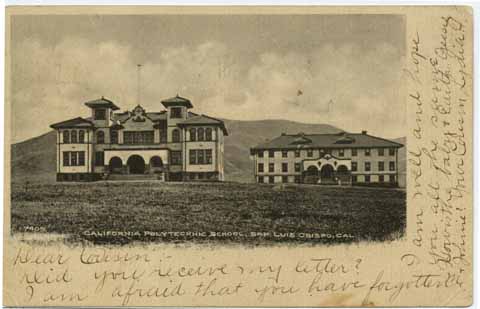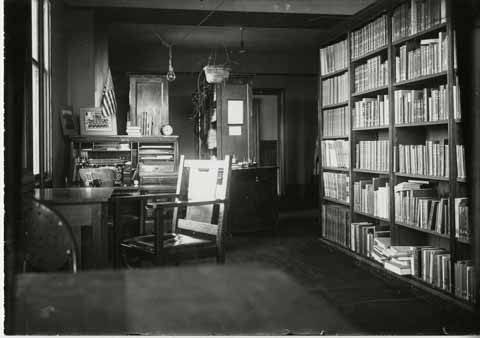University Archives: Researching Cal Poly
- University Archives
- Getting Started
- University Archives Collections
- Digitized Materials - OverviewToggle Dropdown
- Archived Campus Websites
- Student enrollment and demographic data
- Senior Projects and Masters Theses
- Maps and Building Information
- Secondary Sources and timelines
- FAQsToggle Dropdown
- Stories from the Archives
- Research by topic and subject
Get Archives Help

Kennedy Library, Cal Poly
Early library history
The First Cal Poly Library, 1903–1916
Cal Poly’s first library opened in 1903 on the first floor of the original Administration Building. Since the library was adjacent to Director Leroy Anderson’s office, the duties of the librarian were assigned to Naomi Lake, the Director’s secretary.
Image caption: The Administration Building, on the left, housed the first Cal Poly library. The library would later move into Anderson Hall, the building on the right. University Archives Postcard Collection, ua-ast_00000073.
On The Move, 1916–1946
By 1916 the library moved to the second floor of the Science Building, later known as Anderson Hall. Grace Hill was Cal Poly’s first full-time librarian, listed in the course catalog for 1916 (she was also the first advisor of the Polygram, Cal Poly’s first newspaper).
Image caption: First known photograph of the Cal Poly library, after relocated to the Science Building (aka Anderson Hall), circa 1918. University Archives Photo Collection, ua-pho_00000553.
In 1939 the library was relocated to the center of campus, in the newly constructed one-story classroom units. Captain J.C. Deuel, an instructor in Physical Education, served as Cal Poly’s librarian from 1925 to 1941.
In 1942, the library moved to the recently completed Business Administration building (now known as Cotchett Education Building). Future president Robert E. Kennedy, hired as a Journalism professor and publicity manager, was appointed librarian.
“They wanted me to become the librarian–on a temporary basis–of course, just until a qualified librarian could be found to take over. “What about all my other jobs?” I asked. “Oh, you can keep them. You’re doing a fine job and we know that with enrollment dropping off because of World War II, there will be fewer students in your classes, so you can fill in the time buying books, cataloging them, checking them in and out, etc.”
He would continue to serve as librarian until 1946, when Ainsley Whitman was hired as a full-time librarian.
Walter F. Dexter Memorial Library, 1948–1980
 Plans for the first library building began in 1941 but were halted until 1947 due to the war. In 1947, the Office of the California State Architect submitted construction plans of the new library and classroom building, and after approval, construction began.
Plans for the first library building began in 1941 but were halted until 1947 due to the war. In 1947, the Office of the California State Architect submitted construction plans of the new library and classroom building, and after approval, construction began.
Dedicated in October 1948, the $700,000 library memorialized the Sacramento administration Walter Friar Dexter, who had helped secure collegiate status for Cal Poly eight years before. It was the first space specifically designed as the Cal Poly library.
Designed to furnish a well-appointed paradise for bookworms, the new, two-level structure will contain general and reserve reading areas, with storage space designed for 180,000 books…for the less aggressive hunter of knowledge a browsing room with soft chairs and a fireplace is contemplated.
Image: Front page news of the Dexter Library move-in, El Mustang, September 16, 1949. Read the full issue.
 The main floor contained two reading rooms designed to accommodate 500 students (enrollment in 1949 was 2,900 students), a large card catalog system, a lounge with a fireplace, a periodical and reserve room containing 500 different magazine titles, librarian and cataloging offices, and seminar and conference rooms.
The main floor contained two reading rooms designed to accommodate 500 students (enrollment in 1949 was 2,900 students), a large card catalog system, a lounge with a fireplace, a periodical and reserve room containing 500 different magazine titles, librarian and cataloging offices, and seminar and conference rooms.
A scrapbook in the University Archives documents the development and construction of Dexter Library. Flip through the1940-1949 Scrapbook of the development and construction of Dexter.
Image caption: Dexter Library’s periodical reading room, circa 1950. University Archives Photo Collection, ua-pho_00000548.
The Dexter Library Annex, added to the existing structure in 1962, more than doubled the size of the library. The addition offered 1,650 “reader stations” and book storage space for 150,000 volumes on four floors of stacks.
See also:
- Archived blog post "DEXTER: CAL POLY’S FIRST LIBRARY"
Petition for a new library
The rapid increase in student enrollment in the 1950s and 1960s meant that Dexter Library could not meeting the needs of the campus. Enrollment grew to nearly 15,000 full-time-equivalent students and the library became badly overloaded, with students crowding into reading rooms and thousands of books placed in remote storage.[2] By the 1960s, students were calling for new library spaces.
In the 1968 Master Plan, the university proposed a new library adjacent to Dexter. Working drawings for the 205,000-square-foot library building were completed by Marquis Associates of San Francisco in 1971.
However, the campus had to wait on an allocation from the state. By 1977, students joined the call for funds--a petition for state funding was signed by over 7,000 students in 1977.[3] The signatures were bound into a book and presented to the governor by ASI President Ole Meland. The library still has the oversized book in the archives. Meland presented the book to the governor on the steps of the Capitol Building in Sacramento.
Finally, in July 1977, the state legislature budgeted the allocation of construction funds, approved by Governor Edmund Brown Jr.[4] The 1977 bid for construction was 9 million.
Kennedy Library, 1980 - present

The site selected for the library was previously occupied by six temporary wooden barracks and a mess hall built during World War II. The 36-year-old structures were used until the fall of 1977 for faculty offices and laboratories for architecture and child development, and were then relocated on campus, including the "Z-Lab."5
The firm of Robert B. Marquis Associates of San Francisco, who had contributed significantly to the built environment of the Bay Area, particularly public housing and educational building, drew the plans in 1971. The building was three times larger than Dexter, and provided seating capacity for 2,500, compared to Dexter’s seating capacity of 574. The new library provided space for 625,000 volumes, three “rooms for typing,” five photoduplication rooms, and a full staff to manage the expanded collections. A new innovation, the “Automated Retrieval Service,” allowed students to request computer searches, completed by trained librarians, for a a fee of $10.00 and an approximate wait time of three to four days.
Image caption: The proposed new library, designed by Marquis and Associates. University Archives Photo Collection.

The campus broke ground on March 17, 1978. The construction system is concrete frame and exterior, in the Late International Style, similar to Yosemite (1968), Architecture Building (1977), Fisher Science Building (1977), and Vista Grande (1972). The building opened to the public in January 1981.
At the dedication ceremony on April 2, 1981, recently retired Cal Poly President Emeritus Robert E. Kennedy remarked that it was “a special day to recognize the essential function of a library in the educational process, whether it be a little struggling school as Cal Poly was in 1940 or a university with a great reputation–as Cal Poly is today.”
From its origins in one room of the first administration building to the present facility housing a collection of nearly five million items, the library contains rich collections of books, journals, electronic resources, multimedia, K-12 learning resources, and government documents.
Researchers from every state and seven countries have traveled to the Kennedy Library to use our archival collections of manuscripts, rare books, architectural drawings, and photographs. Special Collections materials have been featured on the BBC, CNN, PBS, A&E, and in international print media. As the largest library between Santa Cruz and Santa Barbara, the library also plays a critical role in the surrounding community.
- 24-hour space opened in the 2007-2008 school year, including the addition of Julians coffee shop on the 2nd floor (named after President Julian A. McPhee, formerly located in the University Union)
- Library atrium was remodeled in 2012
- The library building was closed in June 2023 to prepare for the two-year library transformation project.
Digitized campus publications keyword "Marquis"
Image caption: Informational brochure for the new library, circa 1981. Read the brochure (and see the original layout of the library!).
More info
Archived blog post "FROM THE UNIVERSITY ARCHIVES: A SHORT HISTORY OF CAL POLY’S LIBRARIES"
- Last Updated: Jul 18, 2024 2:23 PM
- URL: https://guides.lib.calpoly.edu/university-archives
- Print Page